Yamaha HTR-5920 User Manual

U
HTR-5920
AV Receiver
Ampli-tuner audio-vidéo
OWNER’S MANUAL MODE D’EMPLOI
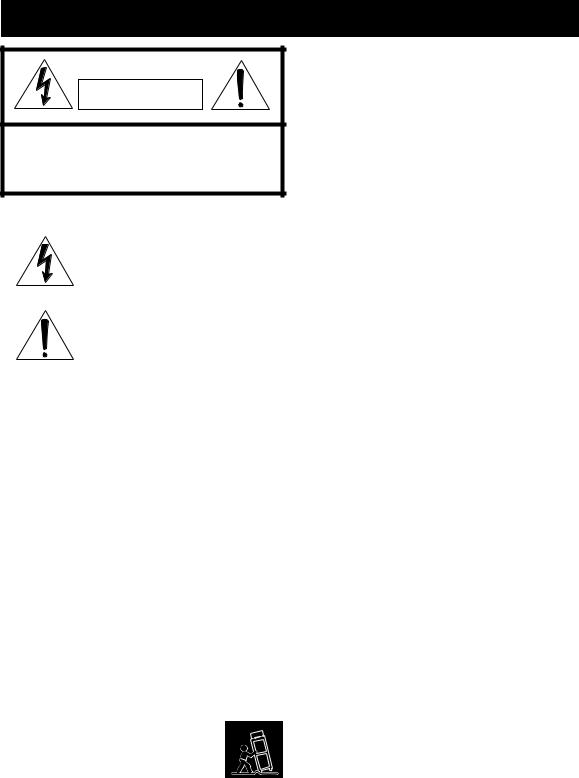
IMPORTANT SAFETY INSTRUCTIONS
CAUTION |
RISK OF ELECTRIC SHOCK |
DO NOT OPEN |
CAUTION: TO REDUCE THE RISK OF |
ELECTRIC SHOCK, DO NOT REMOVE |
COVER (OR BACK). NO USER-SERVICEABLE |
PARTS INSIDE. REFER SERVICING TO |
QUALIFIED SERVICE PERSONNEL. |
•Explanation of Graphical Symbols
The lightning flash with arrowhead symbol, within an equilateral triangle, is intended to alert you to the presence of uninsulated “dangerous voltage” within the product’s enclosure that may be of sufficient magnitude to constitute a risk of electric shock to persons.
The exclamation point within an equilateral triangle is intended to alert you to the presence of important operating and maintenance (servicing) instructions in the literature accompanying the appliance.
1Read Instructions – All the safety and operating instructions should be read before the product is operated.
2Retain Instructions – The safety and operating instructions should be retained for future reference.
3Heed Warnings – All warnings on the product and in the operating instructions should be adhered to.
4Follow Instructions – All operating and use instructions should be followed.
5Cleaning – Unplug this product from the wall outlet before cleaning. Do not use liquid cleaners or aerosol cleaners.
6Attachments – Do not use attachments not recommended by the product manufacturer as they may cause hazards.
7Water and Moisture – Do not use this product near water – for example, near a bath tub, wash bowl, kitchen sink, or laundry tub; in a wet basement; or near a swimming pool; and the like.
8Accessories – Do not place this product on an unstable cart, stand, tripod, bracket, or table. The product may fall, causing serious injury to a child or adult, and serious damage to the product. Use only with a cart, stand, tripod, bracket, or table recommended by the manufacturer, or sold with the product. Any mounting of the product should follow the manufacturer’s instructions, and should use a mounting accessory recommended by the manufacturer.
9A product and cart combination should be moved with care. Quick stops, excessive force, and uneven surfaces may cause the product and cart combination to
overturn.
10Ventilation – Slots and openings in the cabinet are provided for ventilation and to ensure reliable operation of the product and to protect it from overheating, and these openings must not be blocked or covered. The openings should never be blocked by placing the product on a bed, sofa, rug, or other similar surface. This product should not be placed in a built-in installation such as a bookcase or rack unless proper ventilation is provided or the manufacturer’s instructions have been adhered to.
11Power Sources – This product should be operated only from the type of power source indicated on the marking label. If you are not sure of the type of power supply to your home, consult your product dealer or local power company. For products intended to operate from battery power, or other sources, refer to the operating instructions.
12Grounding or Polarization – This product may be equipped with a polarized alternating current line plug (a plug having one blade wider than the other). This plug will fit into the power outlet only one way. This is a safety feature. If you are unable to insert the plug fully into the outlet, try reversing the plug. If the plug should still fail to fit, contact your electrician to replace your obsolete outlet. Do not defeat the safety purpose of the polarized plug.
13Power-Cord Protection – Power-supply cords should be routed so that they are not likely to be walked on or pinched by items placed upon or against them, paying particular attention to cords at plugs, convenience receptacles, and the point where they exit from the product.
14Lightning – For added protection for this product during a lightning storm, or when it is left unattended and unused for long periods of time, unplug it from the wall outlet and disconnect the antenna or cable system. This will prevent damage to the product due to lightning and power-line surges.
15Power Lines – An outside antenna system should not be located in the vicinity of overhead power lines or other electric light or power circuits, or where it can fall into such power lines or circuits. When installing an outside antenna system, extreme care should be taken to keep from touching such power lines or circuits as contact with them might be fatal.
16Overloading – Do not overload wall outlets, extension cords, or integral convenience receptacles as this can result in a risk of fire or electric shock.
17Object and Liquid Entry – Never push objects of any kind into this product through openings as they may touch dangerous voltage points or short-out parts that could result in a fire or electric shock. Never spill liquid of any kind on the product.
18Servicing – Do not attempt to service this product yourself as opening or removing covers may expose you to dangerous voltage or other hazards. Refer all servicing to qualified service personnel.
19Damage Requiring Service – Unplug this product from the wall outlet and refer servicing to qualified service personnel under the following conditions:
a)When the power-supply cord or plug is damaged,
b)If liquid has been spilled, or objects have fallen into the product,
c)If the product has been exposed to rain or water,
i
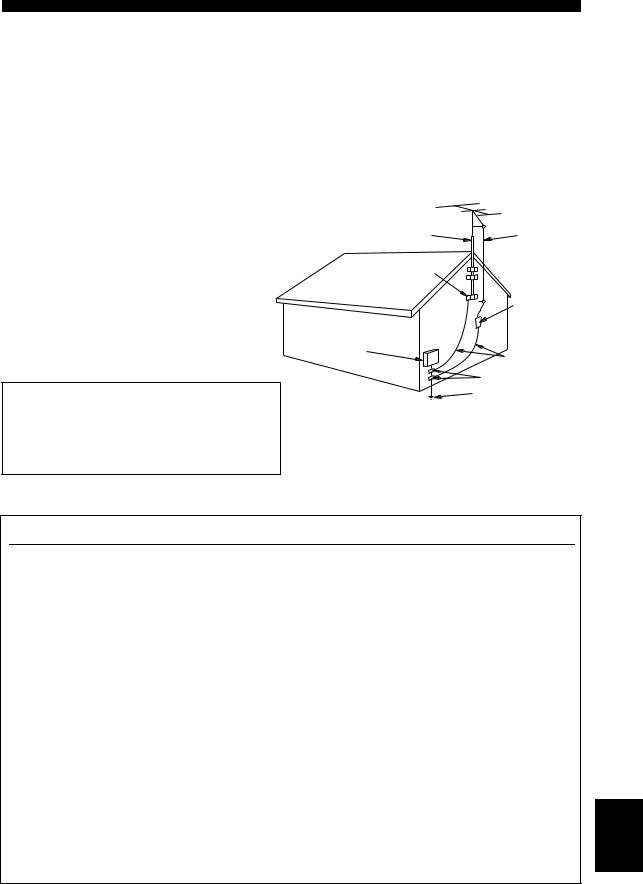
d)If the product does not operate normally by following the operating instructions. Adjust only those controls that are covered by the operating instructions as an improper adjustment of other controls may result in damage and will often require extensive work by a qualified technician to restore the product to its normal operation,
e)If the product has been dropped or damaged in any way, and
f)When the product exhibits a distinct change in perfor-
mance - this indicates a need for service.
20Replacement Parts – When replacement parts are required, be sure the service technician has used replacement parts specified by the manufacturer or have the same characteristics as the original part. Unauthorized substitutions may result in fire, electric shock, or other hazards.
21Safety Check – Upon completion of any service or repairs to this product, ask the service technician to perform safety checks to determine that the product is in proper operating condition.
22Wall or Ceiling Mounting – The unit should be mounted to a wall or ceiling only as recommended by the manufacturer.
23Heat – The product should be situated away from heat sources such as radiators, heat registers, stoves, or other products (including amplifiers) that produce heat.
Note to CATV system installer:
This reminder is provided to call the CATV system installer’s attention to Article 820-40 of the NEC that provides guidelines for proper grounding and, in particular, specifies that the cable ground shall be connected to the grounding system of the building, as close to the point of cable entry as practical.
IMPORTANT SAFETY INSTRUCTIONS
24Outdoor Antenna Grounding – If an outside antenna or cable system is connected to the product, be sure the antenna or cable system is grounded so as to provide some protection against voltage surges and built-up static charges. Article 810 of the National Electrical Code, ANSI/NFPA 70, provides information with regard to proper grounding of the mast and supporting structure, grounding of the lead-in wire to an antenna discharge unit, size of grounding conductors, location of antenna discharge unit, connection to grounding electrodes, and requirements for the grounding electrode.
EXAMPLE OF ANTENNA GROUNDING
MAST |
ANTENNA |
|
LEAD IN |
|
WIRE |
GROUND |
|
CLAMP |
|
|
ANTENNA |
|
DISCHARGE UNIT |
|
(NEC SECTION 810–20) |
ELECTRIC |
|
SERVICE |
|
EQUIPMENT |
GROUNDING CONDUCTORS |
|
|
|
(NEC SECTION 810–21) |
|
GROUND CLAMPS |
|
POWER SERVICE GROUNDING |
|
ELECTRODE SYSTEM |
|
(NEC ART 250. PART H) |
NEC – NATIONAL ELECTRICAL CODE |
|
FCC INFORMATION (for US customers)
1IMPORTANT NOTICE: DO NOT MODIFY THIS UNIT!
This product, when installed as indicated in the instructions contained in this manual, meets FCC requirements. Modifications not expressly approved by Yamaha may void your authority, granted by the FCC, to use the product.
2IMPORTANT: When connecting this product to accessories and/or another product use only high quality shielded cables. Cable/s supplied with this product MUST be used. Follow all installation instructions. Failure to follow instructions could void your FCC authorization to use this product in the USA.
3NOTE: This product has been tested and found to comply with the requirements listed in FCC Regulations, Part 15 for Class “B” digital devices. Compliance with these requirements provides a reasonable level of assurance that your use of this product in a residential environment will not result in harmful interference with other electronic devices.
This equipment generates/uses radio frequencies and, if not installed and used according to the instructions found in the users manual, may cause interference harmful to the operation of other electronic devices.
Compliance with FCC regulations does not guarantee that interference will not occur in all installations. If this product is found to be the source of interference, which can be determined by turning the unit “OFF” and “ON”, please try to eliminate the problem by using one of the following measures:
Relocate either this product or the device that is being affected by the interference.
Utilize power outlets that are on different branch (circuit breaker or fuse) circuits or install AC line filter/s.
In the case of radio or TV interference, relocate/reorient the antenna. If the antenna lead-in is 300 ohm ribbon lead, change the lead-in to coaxial type cable.
If these corrective measures do not produce satisfactory results, please contact the local retailer authorized to distribute this type of product. If you can not locate the appropriate retailer, please contact Yamaha Electronics Corp., U.S.A. 6660 Orangethorpe Ave, Buena Park, CA 90620.
English
ii
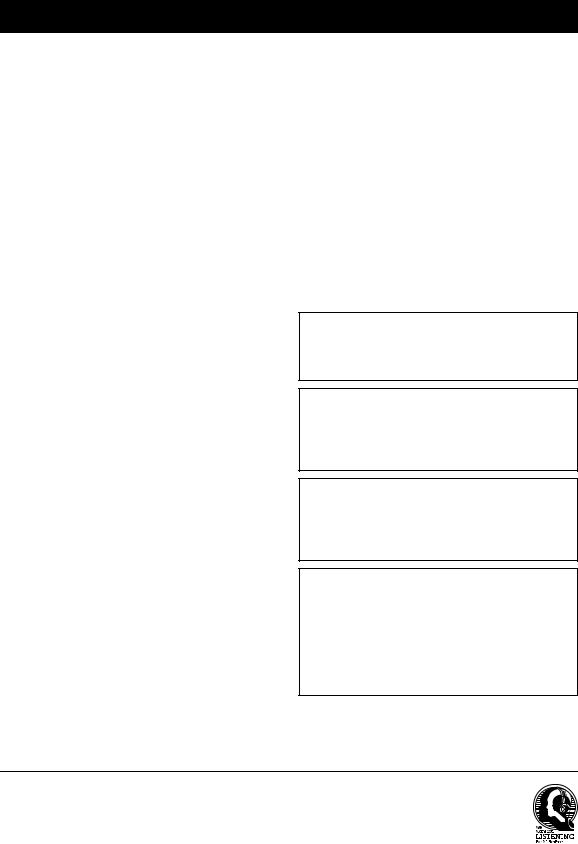
CAUTION: READ THIS BEFORE OPERATING YOUR UNIT.
1To assure the finest performance, please read this manual carefully. Keep it in a safe place for future reference.
2Install this sound system in a well ventilated, cool, dry, clean place – away from direct sunlight, heat sources, vibration, dust, moisture, and/or cold. Allow ventilation space of at least 30 cm on the top, 20 cm on the left and right, and 20 cm on the back of this unit.
3Locate this unit away from other electrical appliances, motors, or transformers to avoid humming sounds.
4Do not expose this unit to sudden temperature changes from cold to hot, and do not locate this unit in a environment with high humidity (i.e. a room with a humidifier) to prevent condensation inside this unit, which may cause an electrical shock, fire, damage to this unit, and/or personal injury.
5Avoid installing this unit where foreign object may fall onto this unit and/or this unit may be exposed to liquid dripping or splashing. On the top of this unit, do not place:
–other components, as they may cause damage and/or discoloration on the surface of this unit.
–burning objects (i.e. candles), as they may cause fire, damage to this unit, and/or personal injury.
–containers with liquid in them, as they may fall and liquid may cause electrical shock to the user and/or damage to this unit.
6Do not cover this unit with a newspaper, tablecloth, curtain, etc. in order not to obstruct heat radiation. If the temperature inside this unit rises, it may cause fire, damage to this unit, and/or personal injury.
7Do not plug in this unit to a wall outlet until all connections are complete.
8Do not operate this unit upside-down. It may overheat, possibly causing damage.
9Do not use force on switches, knobs and/or cords.
10When disconnecting the power cable from the wall outlet, grasp the plug; do not pull the cord.
11Do not clean this unit with chemical solvents; this might damage the finish. Use a clean, dry cloth.
12Only voltage specified on this unit must be used. Using this unit with a higher voltage than specified is dangerous and may cause fire, damage to this unit, and/or personal injury. YAMAHA will not be held responsible for any damage resulting from use of this unit with a voltage other than specified.
13 To prevent damage by lightning, keep the power cord and outdoor antennas disconnected from a wall outlet or the unit during a lightning storm.
14 Do not attempt to modify or fix this unit. Contact qualified YAMAHA service personnel when any service is needed. The cabinet should never be opened for any reasons.
15 When not planning to use this unit for long periods of time (i.e. vacation), disconnect the AC power plug from the wall outlet.
16 Install this unit near the AC outlet and where the AC power plug can be reached easily.
17 Be sure to read the “TROUBLESHOOTING” section on common operating errors before concluding that this unit is faulty.
18 Before moving this unit, press STANDBY/ON to set this unit in the standby mode, and disconnect the AC power plug from the wall outlet.
WARNING
TO REDUCE THE RISK OF FIRE OR ELECTRIC SHOCK, DO NOT EXPOSE THIS UNIT TO RAIN OR MOISTURE.
This unit is not disconnected from the AC power source as long as it is connected to the wall outlet, even if this unit itself is turned off by STANDBY/ON. This state is called the standby mode. In this state, this unit is designed to consume a very small quantity of power.
FOR CANADIAN CUSTOMERS
To prevent electric shock, match wide blade of plug to wide slot and fully insert.
This Class B digital apparatus complies with Canadian ICES-003.
IMPORTANT
Please record the serial number of this unit in the space below.
MODEL:
Serial No.:
The serial number is located on the rear of the unit. Retain this Owner’s Manual in a safe place for future reference.
We Want You Listening For A Lifetime
YAMAHA and the Electronic Industries Association’s Consumer Electronics Group want you to get the most out of your equipment by playing it at a safe level. One that lets the sound come through loud and clear without annoying blaring or distortion – and, most importantly, without affecting your sensitive hearing.
Since hearing damage from loud sounds is often undetectable until it is too late, YAMAHA and the Electronic Industries Association’s Consumer Electronics Group recommend you to avoid prolonged exposure from excessive volume levels.
iii

CONTENTS
INTRODUCTION |
|
FEATURES............................................................. |
2 |
GETTING STARTED............................................ |
3 |
Supplied accessories .................................................. |
3 |
Installing batteries in the remote control ................... |
3 |
CONTROLS AND FUNCTIONS ......................... |
4 |
Front panel ................................................................. |
4 |
Remote control........................................................... |
6 |
Using the remote control ........................................... |
7 |
Front panel display .................................................... |
8 |
Rear panel .................................................................. |
9 |
PREPARATION |
|
CONNECTIONS .................................................. |
10 |
Placing speakers....................................................... |
10 |
Connecting speakers ................................................ |
11 |
Information on jacks and cable plugs ...................... |
13 |
Connecting video components................................. |
14 |
Connecting audio components................................. |
16 |
Connecting the FM and AM antennas ..................... |
17 |
Connecting the power cable..................................... |
18 |
Turning on the power............................................... |
18 |
SETUP ................................................................... |
19 |
BASIC OPERATION |
|
PLAYBACK.......................................................... |
20 |
Basic operations....................................................... |
20 |
Enjoying surround sounds ....................................... |
22 |
FM/AM TUNING ................................................. |
24 |
Automatic tuning ..................................................... |
24 |
Manual tuning.......................................................... |
25 |
Automatic preset tuning........................................... |
25 |
Manual preset tuning ............................................... |
27 |
Selecting preset stations........................................... |
28 |
Exchanging preset stations ...................................... |
29 |
RECORDING ....................................................... |
30 |
ADVANCED OPERATION |
|
ADVANCED OPERATIONS .............................. |
31 |
Using the sleep timer ............................................... |
31 |
Dimming the front panel display ............................. |
31 |
Adjusting speaker levels .......................................... |
32 |
ADDITIONAL INFORMATION |
|
TROUBLESHOOTING ....................................... |
33 |
RESETTING THE SYSTEM............................... |
37 |
GLOSSARY........................................................... |
38 |
Audio formats .......................................................... |
38 |
Audio information ................................................... |
39 |
Video signal information ......................................... |
39 |
SPECIFICATIONS............................................... |
40 |
INTRODUCTION |
|
|
|
|
|
PREPARATION |
|
|
|
|
|
OPERATION |
BASIC |
|
|
|
|
OPERATION |
ADVANCED |
|
|
|
|
INFORMATION |
ADDITIONAL |
|
|
English
1
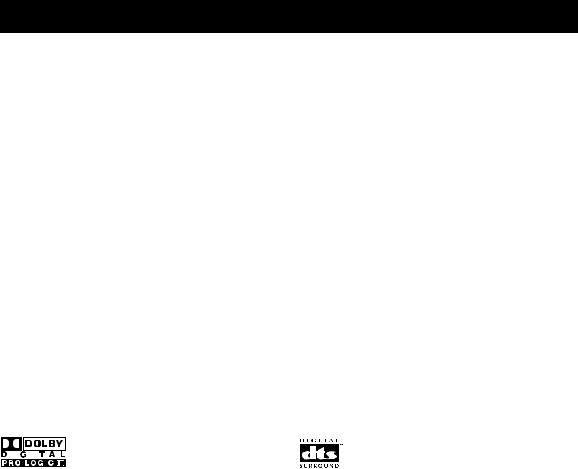
FEATURES
Built-in 6-channel power amplifier
Minimum RMS output power per channel
[Front, center, and surround channels] 80 W (1 kHz, 0.1% THD, 6 Ω)
110 W (1 kHz, 10% THD, 6 Ω)
[Subwoofer channel] 110 W (50 Hz, 6 Ω)
Decoders for multi-channel surround sound
Dolby Digital decoder
Dolby Pro Logic/Dolby Pro Logic II decoder
DTS decoder
Sophisticated AM/FM tuner
40-station random and direct preset tuning
Automatic preset tuning
Preset station shifting capability (preset editing)
Other features
A SET MENU that provides you with items for optimizing this unit for your audio/video system
Component video input/output capability
Optical and coaxial digital audio signal jacks
Sleep timer
•y indicates a tip for your operation.
•Some operations can be performed by using either the buttons on the front panel or on the remote control. In cases when the button names differ between the front panel and the remote control, the button name on the remote control is given in parentheses.
•This manual is printed prior to production. Design and specifications are subject to change in part as a result of improvements, etc. In case of differences between the manual and product, the product has priority.
|
|
|
|
|
“DTS” and “DTS Digital Surround” are registered trademarks of |
|
|
|
|
|
|
|
|
|
|
|
|
Manufactured under license from Dolby Laboratories. |
|||||
“Dolby”, “Pro Logic”, and the double-D symbol are trademarks |
Digital Theater Systems, Inc. |
||||
of Dolby Laboratories. |
|
||||
2
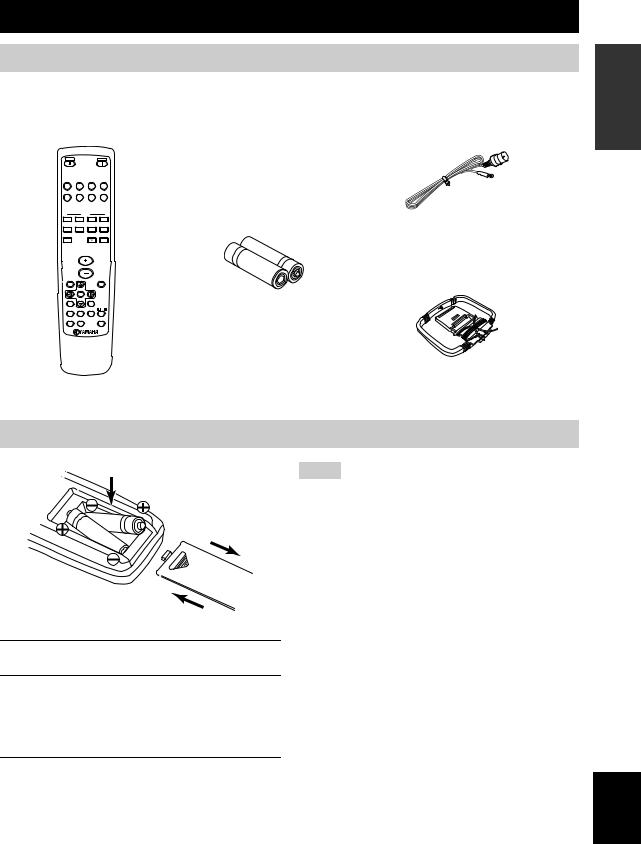
GETTING STARTED
Supplied accessories
Please check that you received all of the following parts.
Remote control |
Indoor FM antenna |
|||
STANDBY |
|
|
POWER |
|
CD |
MD/CD-R TUNER SLEEP |
|
||
DVD |
DTV/CBL VCR |
V-AUX |
|
|
|
TUNER |
|
Batteries (2) |
|
P1 |
P2 |
P3 |
P4 |
(AAA, R03, UM-4) |
P5 |
P6 |
P7 |
P8 |
|
A/B/C/D/E |
|
PRESET |
|
|
|
VOLUME |
|
|
|
SET MENU |
|
MUTE |
AM loop antenna |
|
|
ENTER |
|
|
|
LEVEL |
|
TEST |
|
|
HALL |
JAZZ |
ROCK |
PL |
|
5 STEREO NIGHT |
|
STEREO |
|
|
INTRODUCTION
Installing batteries in the remote control
2
1
3
1Take off the battery compartment cover.
2Insert two supplied batteries (AAA, R03, UM-4) according to the polarity markings (+ and –) on the inside of the battery compartment.
3Snap the battery compartment cover back into place.
Notes
•Change all of the batteries if you notice a decrease in the operation range of the remote control.
•Do not use an old battery together with a new one.
•Do not use different types of batteries (such as alkaline and manganese batteries) together. Read the packaging carefully as these different types of batteries may have the same shape and color.
•If the batteries have leaked, dispose of them immediately. Avoid touching the leaked material or letting it come into contact with clothing, etc. Clean the battery compartment thoroughly before installing new batteries.
•Do not throw away batteries with general house waste; dispose of them correctly in accordance with your local regulations.
English
3
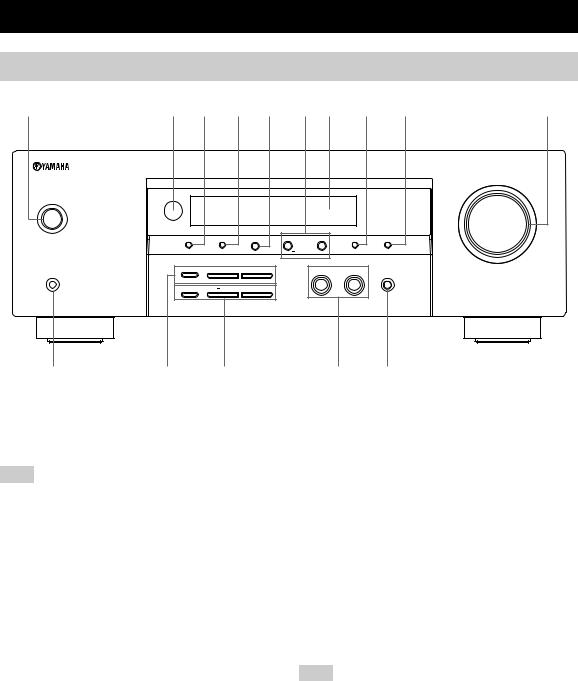
CONTROLS AND FUNCTIONS
Front panel
1 |
2 |
3 |
4 |
5 |
6 7 |
8 |
9 |
0 |
STANDBY |
|
|
|
/ON |
|
|
|
|
PRESET/TUNING |
FM/AM |
A/B/C/D/E |
|
EDIT |
|
NEXT |
PHONES |
STEREO |
l |
PROGRAM h |
|
EFFECT |
|
|
|
TONE CONTROL |
BASS/TREBLE |
|
A B C
1 STANDBY/ON
Turns on this unit or sets it to the standby mode. When you turn on this unit, you will hear a click and there will be a 4 to 5-second delay before this unit can reproduce sound.
Note
In the standby mode, this unit consumes a small amount of power in order to receive infrared-signals from the remote control.
2 Remote control sensor
Receives signals from the remote control.
3 PRESET/TUNING
Switches the function of PRESET/TUNING l/ h between selecting preset station numbers and selecting the tuning frequency.
4 FM/AM
Switches the reception band between FM and AM.
5 A/B/C/D/E
Selects one of the 5 preset station groups (A to E) when this unit is in the tuner mode.
VOLUME
l PRESET/TUNING h |
MEMORY |
TUNING MODE |
SET MENU |
MAN'L/AUTO FM |
AUTO/MAN'L |
l INPUT h
INPUT MODE
D E
6 PRESET/TUNING l / h
Selects one of the preset station numbers (1 to 8) or the tuning frequency when this unit is in the tuner mode.
7 Front panel display
Shows information about the operational status of this unit.
8 MEMORY
Stores a preset station in the memory. Hold down this button for more than 3 seconds to start automatic preset tuning.
9 TUNING MODE
Switches between automatic tuning (the AUTO indicator is turned on) and manual tuning (the AUTO indicator is turned off).
0 VOLUME
Controls the output level of all audio channels.
Note
This does not affect the OUT level.
4

A PHONES jack
Outputs audio signals for private listening with headphones.
Notes
•When you connect headphones, no signals are output to the speakers.
•All Dolby Digital and DTS audio signals (except the LFE channel) are mixed down to the left and right headphone channels.
B STEREO
Switches between normal stereo and DSP effect reproduction. When you select “STEREO”, this unit mixes down all Dolby Digital and DTS signals (except the LFE channel) as well as those 2-channel signals without effect sounds to the front left and right speakers.
PROGRAM l / h
Selects the surround mode.
C TONE CONTROL
Adjusts the bass/treble balance of the front left and right speakers in conjunction with BASS/TREBLE +/–.
BASS/TREBLE +/–
Adjusts the bass/treble balance of the front left and right speakers in conjunction with TONE CONTROL.
D INPUT l / h
Selects the input source you want to listen to or watch.
E INPUT MODE
Sets the priority (AUTO, DTS, ANALOG) for the type of signals received when one component is connected via both digital and analog connections.
CONTROLS AND FUNCTIONS
INTRODUCTION
English
5
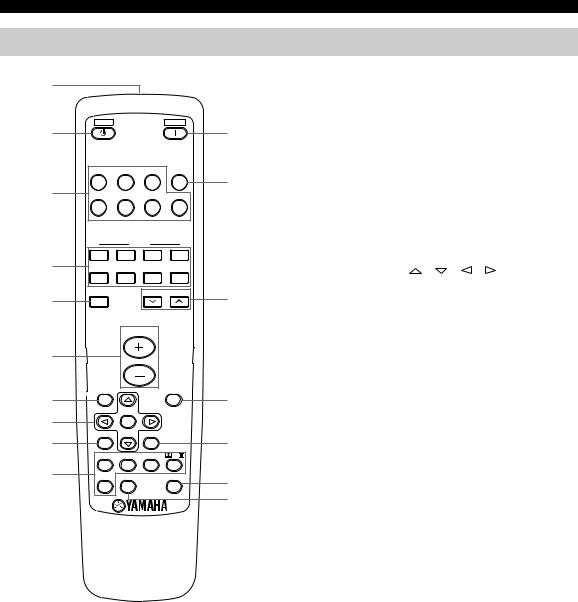
CONTROLS AND FUNCTIONS
Remote control
1
STANDBY |
POWER |
2
CD MD/CD-R TUNER SLEEP
3 DVD DTV/CBL VCR V-AUX
|
|
TUNER |
|
|
|
P1 |
P2 |
P3 |
P4 |
4 |
|
|
|
|
|
P5 |
P6 |
P7 |
P8 |
5 |
A/B/C/D/E |
|
PRESET |
|
|
|
|
|
|
|
|
VOLUME |
|
|
6 |
|
|
|
|
|
SET MENU |
|
|
MUTE |
7 |
|
|
|
|
8 |
|
ENTER |
|
|
|
|
|
|
|
9 |
LEVEL |
|
TEST |
|
|
|
|
|
|
|
HALL |
JAZZ |
ROCK |
PL |
0 |
5 STEREO |
NIGHT |
|
STEREO |
1Infrared signal transmitter
Outputs infrared control signals.
2STANDBY
Sets this unit in the standby mode.
3 Input selector buttons
Select the input source.
|
4 |
Preset station number selector buttons |
|
|
|
(P1 to P8) |
|
|
Select the preset station number (1 to 8) directly when this |
||
|
unit is in the tuner mode. |
||
A |
5 A/B/C/D/E |
||
|
Selects a preset station group (A to E) when this unit is in |
||
|
the tuner mode. |
||
B |
6 |
VOLUME +/– |
|
|
|||
|
Increases or decreases the volume level. |
||
|
7 |
SET MENU |
|
|
Activates the SET MENU function. |
||
|
8 |
Cursor buttons / / / , ENTER |
|
C |
Select and adjust the SET MENU items. |
||
9 |
LEVEL |
||
|
|||
|
Selects the speaker channel to be adjusted and sets the |
||
|
output level. |
||
|
0 |
Surround mode selector buttons |
|
Select the surround modes.
DA POWER
Turns on this unit.
EB SLEEP
Sets the sleep timer.
FC PRESET u / d
GSelect a preset station number (1 to 8) when this unit is in the tuner mode.
D MUTE
Mutes the audio output. Press MUTE again to restore the audio output to the previous volume level.
E TEST
Outputs the test tone to adjust the speaker levels.
F STEREO
Switches between normal stereo and DSP effect reproduction. When you select “STEREO”, this unit mixes down all Dolby Digital and DTS signals (except the LFE channel) as well as those 2-channel signals without effect sounds to the front left and right speakers.
G NIGHT
Turns on or off the night listening mode. The night listening mode is available only for Dolby Digital sources.
6
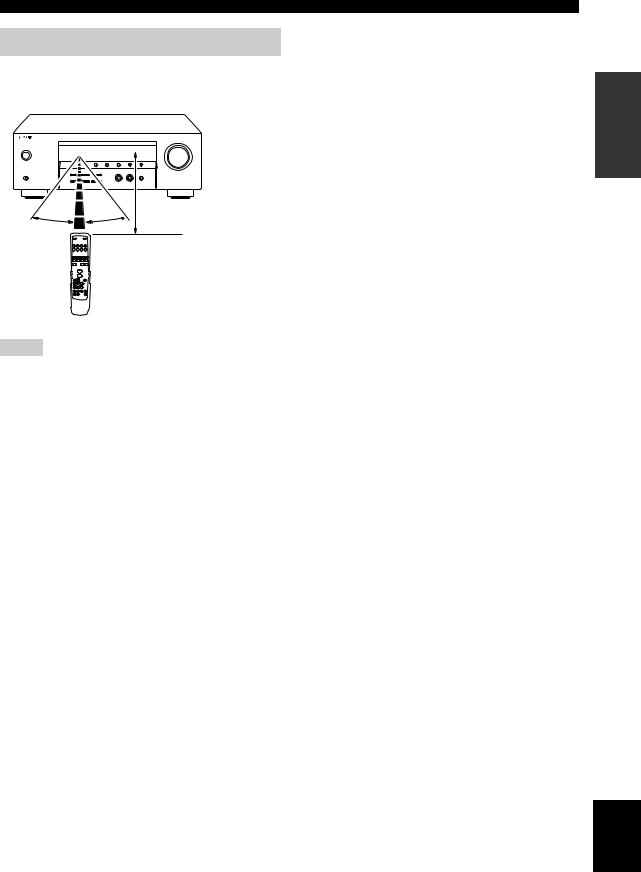
Using the remote control
The remote control transmits a directional infrared beam. Be sure to aim the remote control directly at the remote control sensor on the front panel during operation.
30º |
30º |
Approximately 6 m (20 ft) |
Notes
•Do not spill water or other liquids on the remote control.
•Do not drop the remote control.
•Do not leave or store the remote control in the following types of conditions:
–places of high humidity, such as near a bath
–places of high temperature, such as near a heater or stove
–places of extremely low temperatures
–dusty places
CONTROLS AND FUNCTIONS
INTRODUCTION
English
7

CONTROLS AND FUNCTIONS
Front panel display
1 |
|
|
|
|
|
2 |
3 |
4 |
5 |
6 |
|
7 |
89 |
|||||||||||||||||
|
|
|
|
|
|
|
|
|
|
|
|
|
|
|
|
|
|
|
|
|
|
|
|
|
|
|
|
|
|
|
|
|
|
|
|
|
|
|
|
|
|
|
|
|
|
|
|
|
|
|
|
|
|
|
|
|
|
|
|
|
|
|
|
|
|
|
|
|
MUSIC |
HALL |
|
5 STEREO |
|
ANALOG |
FM |
STEREO |
AUTO PRESET MUTE |
|
||||||||||||||
|
|
t |
|
|
||||||||||||||||||||||||||
|
|
|
|
|
MOVIE |
JAZZ |
ROCK NIGHT |
|
DIGITAL |
|
AM |
|
TUNED |
MEMORY |
LFE |
|
|
|
||||||||||||
|
|
|
|
q D |
|
|
|
|
|
|
||||||||||||||||||||
|
|
|
|
|
|
|
|
|
|
|
|
|
|
|
|
|
|
|
dB |
|
|
|
|
|
|
|
|
|||
|
|
|
|
|
|
|
|
|
|
|
|
|
|
|
|
|
|
|
|
L |
C R |
|
||||||||
|
|
q PLII q PL |
|
|
|
|
|
|
|
|
|
|
|
|
|
|
|
|
|
|||||||||||
|
|
PCM SLEEP |
|
|
|
|
|
|
|
|
|
|
|
|
|
|
|
kHz |
|
SL |
|
|
|
SR |
|
|||||
|
|
|
|
|
|
|
|
|
|
|
|
|
|
|
|
|
MHz |
|
|
|
|
|
||||||||
|
|
|
|
|
|
|
|
|
|
|
|
|
|
|
|
|
|
|
|
|
|
|
|
|
|
|
|
|
|
|
|
|
|
|
|
|
|
|
|
|
|
|
|
|
|
|
|
|
|
|
|
|
|
|
|
|
|||||
|
|
0 A B |
|
|
|
|
|
|
|
|
|
C |
|
D |
|
|
E |
|||||||||||||
1 Decoder indicators |
|
|
|
8 MUTE indicator |
|
|
|
|
|
|
|
|
|
|
|
|
|
|||||||||||||
The respective indicator lights up when any of the |
Flashes while the MUTE function is on. |
|
|
|
|
|
|
|
||||||||||||||||||||||
decoders of this unit function.
9 LFE indicator
2Surround mode indicators, listening mode indicators
The respective indicator lights up when you select any of the surround mode or the listening mode.
3 Input signal indicators
The respective indicator lights up according to the input signal.
4 Band indicator
The respective indicator lights up according to the current band.
5 STEREO indicator
Lights up when this unit is receiving a strong signal for an FM stereo broadcast while the AUTO indicator is lit.
6 AUTO indicator
Lights up when this unit is in the automatic tuning mode.
7 PRESET indicator
Lights up when this unit is in the preset station selecting mode.
Lights up when the input signal contains the LFE signal.
0 PCM indicator
Lights up when this unit is reproducing PCM (Pulse Code Modulation) digital audio signals.
A SLEEP indicator
Lights up while the sleep timer is on.
B Multi-information display
Shows the current input source name and other information when adjusting or changing settings.
C TUNED indicator
Lights up when this unit is tuned into a station.
D MEMORY indicator
Flashes to show that a station can be stored.
E Input channel indicators
Indicate the channel components of the current digital input signal.
8
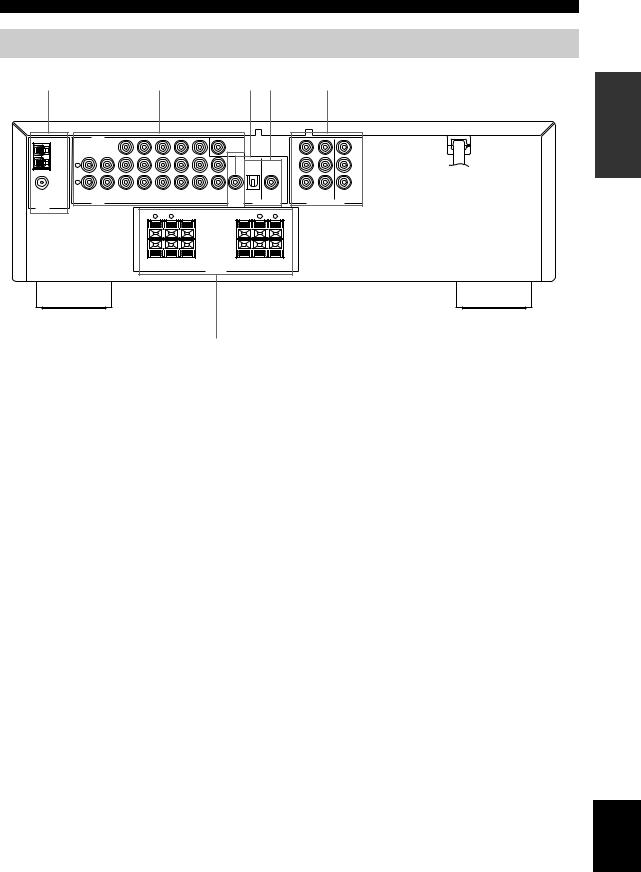
Rear panel
1 |
2 |
3 4 |
5 |
|
|
VIDEO |
|
|
|
|
|
|
|
|
|
|
|
MONITOR |
|
|
Y |
AM ANT |
|
|
|
|
OUT |
|
|
|
|
|
|
|
|
|
|
||
|
|
|
|
|
|
|
|
|
GND |
L |
|
|
|
|
OPTICAL |
COAXIAL |
PB |
|
|
|
|
|
||||
|
|
|
|
|
|
|
||
75Ω UNBAL. |
|
|
|
|
|
|
|
|
FM ANT |
R |
|
|
|
|
|
|
PR |
|
IN |
OUT |
IN |
OUT |
SUB |
DTV/CBL |
DVD |
|
|
MD/CD–R |
DVD DTV/CBL V–AUX |
VCR |
CD WOOFER |
|
|||
|
|
AUDIO |
|
|
OUTPUT |
DIGITAL INPUT |
|
|
TUNER |
|
SUB |
|
CENTER |
FRONT |
SURROUND |
|
||||
R |
L |
WOOFER |
|
R |
L |
+ |
|
+ |
+ |
|
+ |
– |
|
– |
– |
|
– |
|
6ΩMIN./SPEAKER |
|
6ΩMIN./SPEAKER |
||
|
|
CLASS 2 WIRING |
|
|
|
|
|
|
SPEAKERS |
|
|
DVD DTV/CBL MONITOR OUT
COMPONENT VIDEO
CONTROLS AND FUNCTIONS
INTRODUCTION
6
1 Antenna terminals
See page 17 for connection information.
4 DIGITAL INPUT jacks
See page 13 for connection information.
2 Audio and video jacks
See page 13 for connection information.
3 SUBWOOFER OUTPUT jack
See page 12 for connection information.
5COMPONENT VIDEO jacks
See page 13 for connection information.
6Speaker terminals
See page 11 for connection information.
English
9
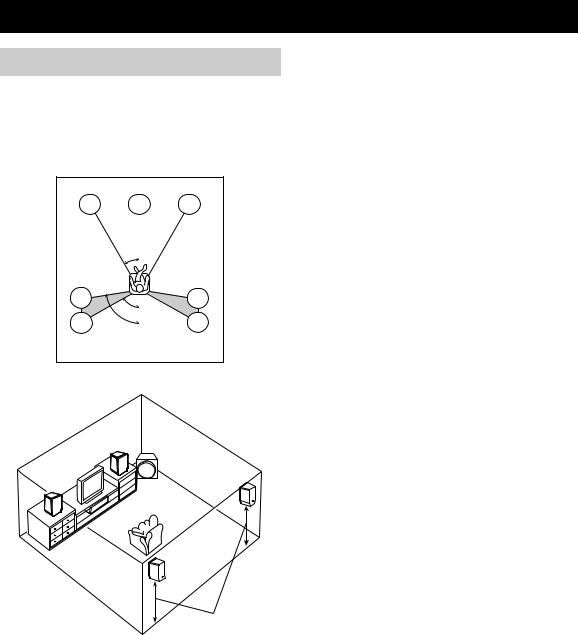
CONNECTIONS
Placing speakers
The speaker layout below shows the standard ITU-R* speaker setting. You can use it to enjoy surround sounds.
*ITU-R is the radio communication sector of the ITU (International Telecommunication Union).
FL |
C |
FR |
30˚
SL |
|
SR |
|
|
60˚ |
SL |
80˚ |
SR |
Front speakers (FR and FL)
The front speakers are used for the main source sound plus effect sounds. Place these speakers an equal distance from the ideal listening position. The distance of each speaker from each side of the video monitor should be the same.
Center speaker (C)
The center speaker is for the center channel sounds (dialog, vocals, etc.). If for some reason it is not practical to use a center speaker, you can do without it. Best results, however, are obtained with the full system. Align the front face of the center speaker with the front face of your video monitor. Place the speaker centrally between the front speakers and as close to the monitor as possible, such as directly over or under it.
Surround speakers (SR and SL)
The surround speakers are used for effect and surround sounds. Place these speakers behind your listening position, facing slightly inwards, about 1.8 m (6 ft) above the floor.
Subwoofer
The use of a subwoofer is effective not only for reinforcing bass frequencies from any or all channels, but also for high fidelity reproduction of the LFE (lowfrequency effect) channel included in Dolby Digital and DTS software. The position of the subwoofer is not so critical, because low bass sounds are not highly directional. But it is better to place the subwoofer near the front speakers. Turn it slightly toward the center of the room to reduce wall reflections.
1.8 m (6 ft)
10
